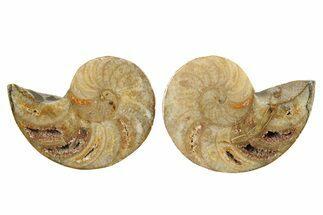This Specimen has been sold.
13.9" Orange, Crystal Filled, Cut Ammonite Fossil - Jurassic
This is a large, 13.9" wide, cut and polished ammonite fossil collected in the Tulear Province of Madagascar. Most of the cut and polished ammonites that you see from Madagascar are Cretaceous in age, but these with orange/yellow/pink coloration are are Late Jurassic (Oxfordian Stage) in age, nearly 50 million years older.
The previously hollow chambers of the ammonite became filled with crystals after the ammonite fossilized creating almost a geode like structure. The ammonite has been cut in half and polished to reveal these crystal filled chambers. The very center of the ammonite has been composited from another partial specimen because it was not very well defined. this is very frequently the case with larger ammonites. The back side of the ammonite has been stabilized with epoxy.
It comes with a pair of metal display stands.
The previously hollow chambers of the ammonite became filled with crystals after the ammonite fossilized creating almost a geode like structure. The ammonite has been cut in half and polished to reveal these crystal filled chambers. The very center of the ammonite has been composited from another partial specimen because it was not very well defined. this is very frequently the case with larger ammonites. The back side of the ammonite has been stabilized with epoxy.
It comes with a pair of metal display stands.
About Ammonites
Ammonites were ancient marine cephalopods, similar to today's squids and octopuses, but with a defining feature: their distinctive, tightly coiled spiral shells. These shells, resembling those of modern nautiluses, served as both a protective home and a buoyancy aid, allowing ammonites to navigate the prehistoric seas with ease. First emerging around 240 million years ago in the Triassic Period, ammonites thrived for over 175 million years, adapting through numerous forms and sizes. As predatory creatures, they likely fed on smaller marine organisms, using their tentacles to capture prey. However, their long reign came to an end 65 million years ago at the close of the Cretaceous, coinciding with the mass extinction event that also eliminated the dinosaurs.
Ammonites were ancient marine cephalopods, similar to today's squids and octopuses, but with a defining feature: their distinctive, tightly coiled spiral shells. These shells, resembling those of modern nautiluses, served as both a protective home and a buoyancy aid, allowing ammonites to navigate the prehistoric seas with ease. First emerging around 240 million years ago in the Triassic Period, ammonites thrived for over 175 million years, adapting through numerous forms and sizes. As predatory creatures, they likely fed on smaller marine organisms, using their tentacles to capture prey. However, their long reign came to an end 65 million years ago at the close of the Cretaceous, coinciding with the mass extinction event that also eliminated the dinosaurs.
SPECIES
Unidentified
LOCATION
Sakaraha, Tulear Province, Madagascar
SIZE
13.9" wide (each half)
CATEGORY
SUB CATEGORY
ITEM
#168535
We guarantee the authenticity of all of our specimens.
 Reviews
Reviews
















